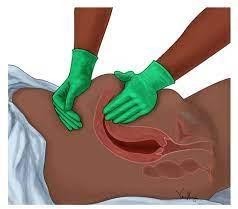A nurse in an antepartum clinic is reinforcing teaching with a client who is pregnant and has a new prescription for oral ferrous sulfate. Which of the following statements by the client indicates an understanding of the teaching?
"I will take this medication with breakfast."
“I will take this medication with my midday meal."
"I will take this medication with a glass of orange juice."
"I will take this medication with a glass of milk."
The Correct Answer is C
A) Incorrect- Taking the medication with breakfast may not ensure optimal absorption of iron, especially if the breakfast does not include a vitamin C source.
B) Incorrect- Taking the medication with the midday meal is not the best option for enhancing iron absorption.
C) Correct - Taking the medication with a glass of orange juice provides a source of vitamin C, which can improve iron absorption.
D) Incorrect- Taking the medication with milk is not recommended, as calcium in milk can interfere with iron absorption.
Nursing Test Bank
Naxlex Comprehensive Predictor Exams
Related Questions
Correct Answer is D
Explanation
Rationale:
A) Incorrect - Applying oxygen is not the priority action in the case of excessive vaginal bleeding and a boggy uterus. Oxygen therapy would be appropriate if there were signs of respiratory distress or decreased oxygen saturation, but it does not directly address the primary concern of uterine atony and bleeding.
B) Incorrect - Administering methylergonovine might be appropriate, but the priority is to address the uterine atony with fundal massage first. Fundal massage helps stimulate uterine contractions and control bleeding, which is crucial in this scenario.
C) Incorrect - Encouraging the client to empty her bladder is important, but it is not the first action to take in the case of excessive bleeding and uterine atony. Immediate intervention to control the bleeding takes precedence.
D) Correct - Initiating fundal massage is the priority action in this situation. A boggy uterus with excessive vaginal bleeding indicates uterine atony, which is a potentially life-threatening condition requiring immediate intervention to prevent further bleeding.
Fundal massage helps the uterus contract and control bleeding. Addressing uterine atony is critical to prevent further hemorrhage and stabilize the client's condition.

Correct Answer is B
Explanation
A) Incorrect- Urinary retention can be a concern but is not as immediately life-threatening as respiratory depression.
B) Correct - A respiratory rate of 11/min is significantly lower than the normal range and indicates respiratory depression, which can be life-threatening. It requires immediate attention.
C) Incorrect- A blood pressure of 105/62 mm Hg is within a normal range for an adolescent and does not require immediate intervention.
D) Incorrect- Blurred vision might be a side effect of medications, but respiratory depression takes priority due to its potential to lead to serious complications.
Whether you are a student looking to ace your exams or a practicing nurse seeking to enhance your expertise , our nursing education contents will empower you with the confidence and competence to make a difference in the lives of patients and become a respected leader in the healthcare field.
Visit Naxlex, invest in your future and unlock endless possibilities with our unparalleled nursing education contents today
Report Wrong Answer on the Current Question
Do you disagree with the answer? If yes, what is your expected answer? Explain.
Kindly be descriptive with the issue you are facing.
